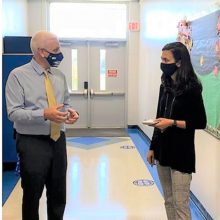
As Forthright Advising notes, the pressure on traditional public school enrollment is coming from enrollment declines linked to the pandemic, our youngest learners delaying the start of schooling, and the collective pressure from charter schools, private schools, and homeschools.
This data and analysis of market share by school type is intended to invite a more nuanced discussion of market share county by county. The data is not perfect, and in part, that is what makes it interesting.
Here is our data in a spreadsheet. Here is our methodology.
Before we talk about what we see in the data and the questions it raises, let’s talk about our methodology.
We use data from Office of State Budget and Management to look at projections of overall population of children by county and think about how many zero to four-year-olds will need educational services in the coming years.
From the number of five to 18-year-olds in each county, we subtract the number of students in that county that attend traditional public schools, charter schools, private schools, and estimated in homeschools.
In counties where there is a remainder, a category called “other” in our analysis, it may help us begin to assess how many students county by county are missing. We wonder if a historical analysis prior to COVID-19 would be instructive.
In counties where the remainder is negative, one possibility is educational options there are attracting students from neighboring counties. What other explanations come to mind?
The data lead us to wonder about traditional public school districts that appear to be serving more than 90% of the students in counties like Currituck, Cabarrus, and Pender. In 93 of 100 counties, 60% or more of students are served by traditional public schools. The median is 75%.
Further inquiry is warranted where the charter school market share appears to exceed 25% in counties like Northampton, Pamlico, and Vance. We allocated enrollment to the county where the charter school is located, but we’d like to know charter school enrollment by county for the most recent ADM data.
In three counties — Bertie, Hertford, and Lenoir — market share of private schools appears to exceed 10%.
We are curious about the number of students being educated in homeschools in Ashe, Graham, Madison, and Yancey counties where the market share is at or above 20%.
This analysis allows us to begin a conversation county by county about the collective impact of market share on traditional public schools.
We wonder how these trends are changing over time and plan to do more research.
Note that you can see what may be errors in the data. Most noticeably in Camden County, there appear to be more students enrolled in public schools than we would expect given the 5-18 population estimates. We will be following up to learn more.
Please let us know what trends you see in the data and the impact of market share pressure on your traditional public schools.
Behind the Story
Analisa Sorrells compiled and analyzed the data on market share for this article.





